There’s a reason so many Americans have written books and poems and songs about Paris: It’s a mind-bendingly fascinating cultural, historic, and architectural contrast to the United States. On more than one ocassion on each of the five days I recently spent there I found myself whispering to my wife Juli, mouth agape in awe during one of our many marathon walks, “I have never seen anything like this before.”
We probably walked an average of 10-12 miles a day. Many of the things that left us awe-struck have absolutely nothing to do with bikes or transportation (remember, I wasn’t there to work), so I won’t bore you with them here. I did however manage to snap a bunch of photos of wonderful things that are more on-topic and that might be of interest. I’ve put them in four categories: The Bikes, People on Bikes, Street Scenes, and Bikeways.
The Bikes
Mixtes are to Paris what those old old, upright, bomb-proof, black dutch bikes are to Amsterdam. I liked the mixte aesthetic before going to Paris and I had no idea they were the official bike of France. What I loved about the bikes I saw in Paris were that so many of them were French brands like Peugeot, Gitane, Motobecane, Nord France, and so on. They even had mixtes made by pro racing legends like Jacques Anquetil, Francesco Moser, Raymond Poulidor, and others.
People on Bikes
Someday when I’ve finally achieved my goals for BikePortland, I want to travel the world and photograph people on bikes. In Paris, my veloflaneurism (not a real word) was taken to new heights. I found that — even without world-class cycling infrastructure (see below) — Parisians’ well-known mix of style, personal confidence, and full embrace of everday life translates beautifully to cycling. It’s easy to look cool and relaxed on a bike in bike-oriented places like Amsterdam or Copenhagen; but Paris? Despite an unsophisticated bike network, Parisians manage to ride with sophistication.

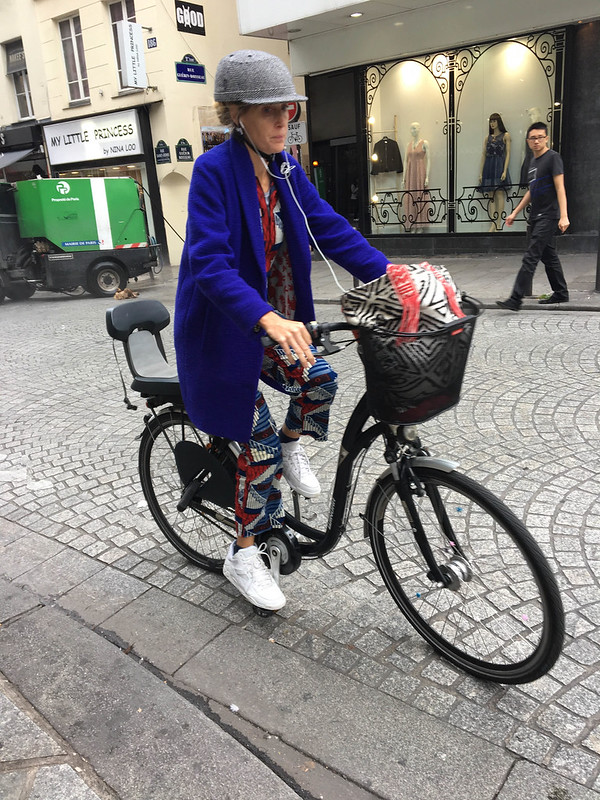


This messenger was taking a break while snacking on a baguette.

Street Scenes
Paris is legendary for its street life. To me, the everyday tableaus and urban vignettes were a mix of art and poetry and placemaking — all unfolding in real life. Walking in Paris was like a dream.
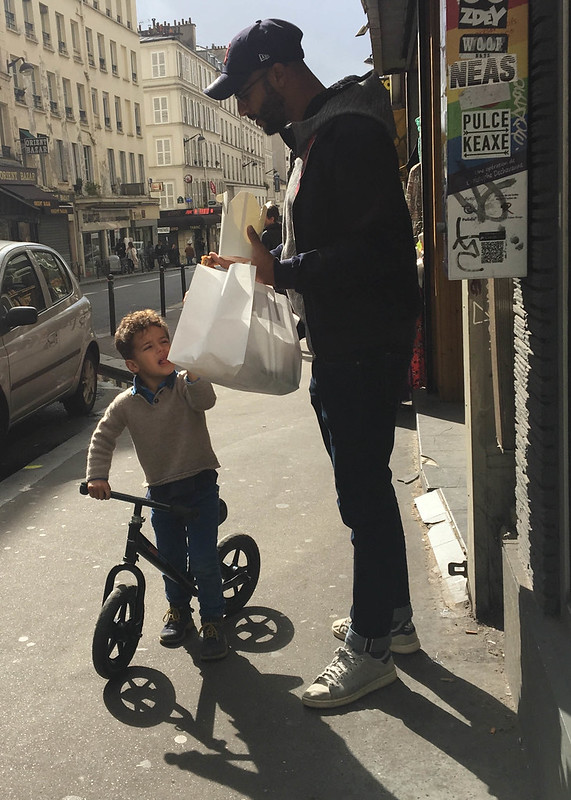


Advertisement

Bikeways
Now for some serious business. I found the bikeways in Paris to be an extremely mixed bag. It’s clear they’ve thought about a complete network of bikeways. And in many ways that network exists. But — and this is a big but — the network is full of gaps and high-stress, shared environments. As newbies to the city, it was often a challenge to follow the convoluted, faint breadcrumbs of striping and paint and signs that would get us through town alive and with relative efficiency.
For example, bikeways on the Rue Magenta (a major street) go from a narrow path on the sidewalk (where walkers have priority) to a narrow dedicated bikeway in a park in the center of the boulevard, to a shared bus-bike lane that would give most Americans a heart attack.
They also have a fair number of really sketchy, contraflow bikeways without any real striping or protection at all. Just one bike symbol and an arrow pointing against traffic and a very narrow slot to ride (see below).
And then there are the massive traffic circles. If you can find the bikeway, you’ve won half the battle. The other half is getting up the nerve to ride in it.
All this being said, once you just go-with-the-flow, it’s much lower-stress riding than you’d expect given the infrastructure. Why? Culture. America has an extremely hostile and divisive traffic culture where road users have built-up considerable animosity for one another. Add in the our lack of respect for others and a pervasive car culture centered around speed, machismo, oversized vehicles, and distraction; and people have reason to be afraid to ride bikes here.
Paris felt different. People don’t appear to have the same fears about traffic. I saw many older women wearing dresses and no helmet ride in the middle of massive boulevards and traffic circles during rush-hour in what would appear to American eyes as a death-wish. It’s amazing what can happen on streets when people don’t assume their fellow road users are out to kill them (willfully or “accidentally”).

Even without world-class non-motorized infrastructure, it’s amazing how relaxed people can be when they have faith in each other and mutual respect.
And a word about their bike share system, Velib. It’s a vital resource for Paris and a huge success. While Portland’s Biketown is used mostly by tourists, Velib is used by locals. The bikes are everywhere and I was heartened to see it have such a strong hold on the city. But when it comes to details, it’s nowhere near as good as Biketown. Several times I rented a bike that was poorly maintained and a pain to ride. The seatposts don’t go high enough (I’m only 6′ 2″). And the stations aren’t balanced (we pedaled around looking for a spot to park more than once). We’re lucky to have such a well-run system like Biketown! (Granted, our system is very small by comparison. We have 1,000 bikes, they have nearly 20,000.)

A walking priority zone. Note how the sign shows priority based on size of the symbol.



Thanks for looking at my vacation photos. If you’ve been to Paris, I’d love to hear from you.
— Jonathan Maus: (503) 706-8804, @jonathan_maus on Twitter and jonathan@bikeportland.org
Never miss a story. Sign-up for the daily BP Headlines email.
BikePortland needs your support.








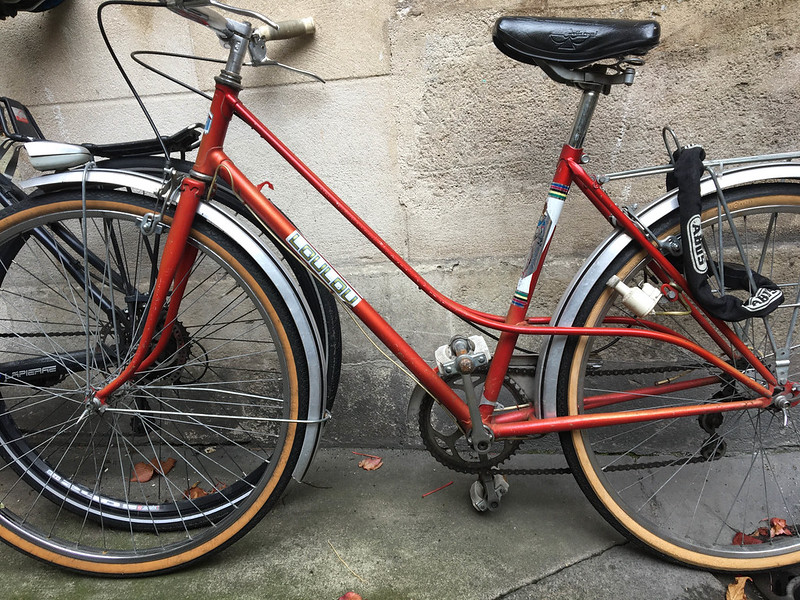

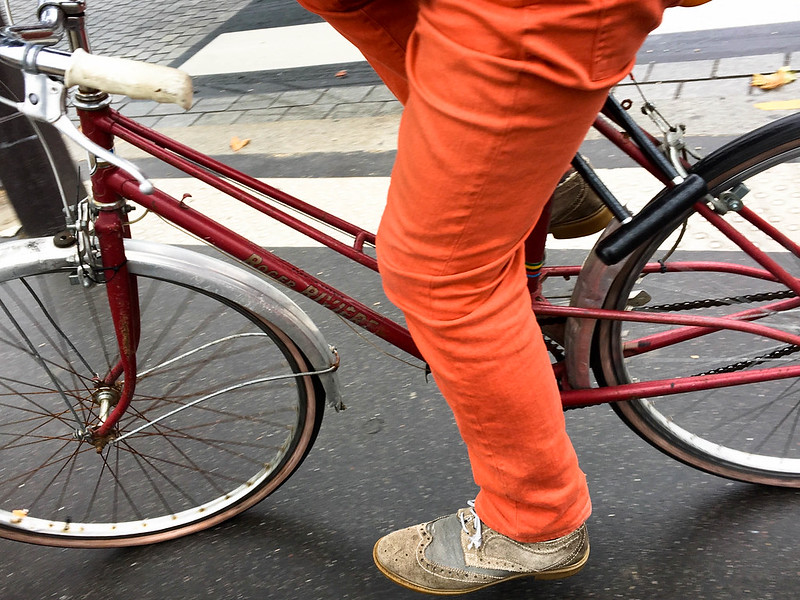












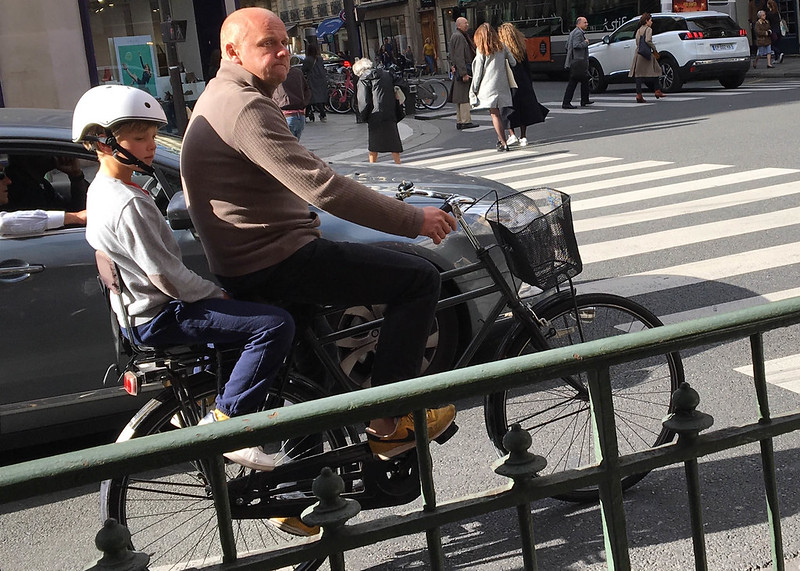
















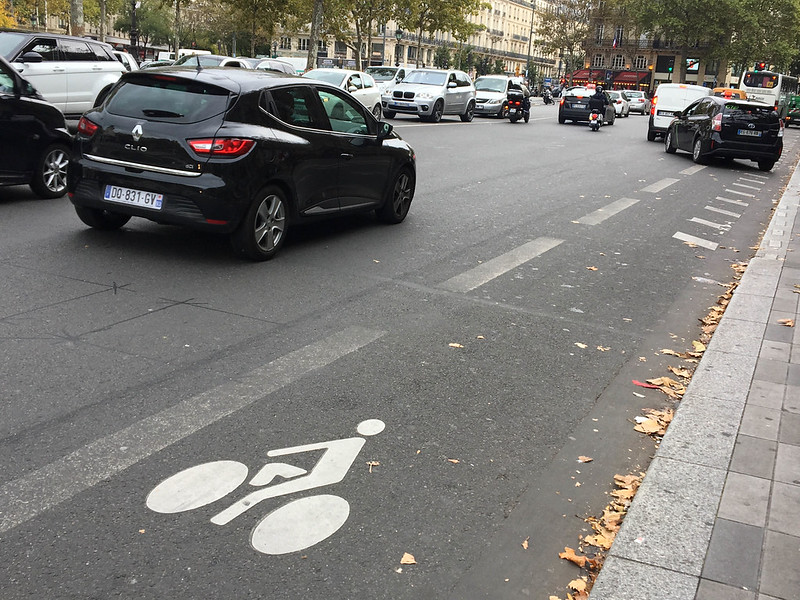





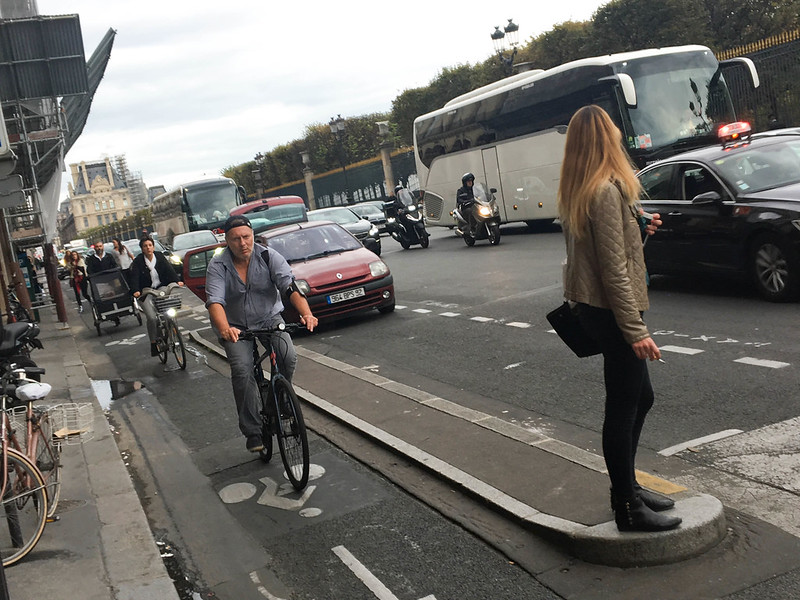




Thanks for reading.
BikePortland has served this community with independent community journalism since 2005. We rely on subscriptions from readers like you to survive. Your financial support is vital in keeping this valuable resource alive and well.
Please subscribe today to strengthen and expand our work.
What a difference when motor vehicles are de-emphasized and humans ard priotlritized!
I think it all depends on where. There are a lot of highways in Europe also…however, the attitude is just different. I have never felt unsafe cycling in Europe, even on major roads. Here, very different.
I partially blame post WWII economics for the differences in attitude towards bikes on the streets between the U.S and France. For 20 or 25 years following the end of the war the French ( many other europeans also) were relatively poor and most of them could not afford cars. So far more of them cycled or walked ( the built environment helped). So most adults grew up cycling and so did their parents and grandparents. These means that when they are driving one of those folks on bikes in traffic could be their mother, and they drive accordingly. While immediatly after WWII here in the U.S we had an economic boom the promised suburban homes and automobiles for all. Culturally bikes became toys for children and not serious transportation for adults, and this attitude lasted until the 70’s bike boom. So in the minds of many american drivers of all ages, people on bikes are nothing but kids playing on the street and getting in their way.
Agreed. Here in Florida, competitive cycling is a recognized and popular activity but utility riding is only for the poor and not really even children, anymore.
Good point. Also, the US literally tore up its trolley infrastructure and developed suburbia thereby forcing people into car ownership. In Europe, cars were and continue to be a choice. In America, cars were a necessity but this is slowly changing for select urban areas.
However, there is much higher bike culture in Europe than the US. The races, the products, the mindset about bicycles is all different.
It would be interesting to compare how ebikes do across the two markets.
We loved Paris this summer. Like you, Jonathan, we mostly did lots of walking. But we did use hotel bikes one day, and the combined bus/bike/taxi lanes on major streets are pretty stressful. The now carless streets next to the Seine invite bikes, but during the summer the number of pedestrians enjoying a riverside stroll often make riding difficult. We loved the cafes and history, and food in Paris in absolutely amazing — and the best is often found in the small local places. And it is also hard to beat Parisian fashion; I bought inexpensive clothes in the French equivalent of Macy’s and people here compliment my style. I can’t wait to return!
I definitely hear you about the fashion Danny. We loved shopping and looking at all of it. Sounds like you had a similar experience as we did. Although I liked the shared bus/bike/taxi lanes! It’s so much space and I trusted the motorized users to not kill me or do stupid things.
Anti-helemt comment in
…3
…2
…1
uh…
…3/4
err…
…1/2
…1/4
It blew my mind to see step through vintage Pinarellos in Bolzano.
Jonathan: My daughter (11), son (9), wife, and I went to Paris, Rotterdam, and Amsterdam this summer. All four of us (yes, even my nine-year-old) availed ourselves of the bike share program, Velib, daily while in Paris. What an incredible way to experience one of the most incredible cities in the world! Yes, the infrastructure in Paris sucks compared to the Dutch cities’ but riding in Paris gave us indelible memories.
That’s great to hear Lars. We also loved being on the Velib bikes (despite my nitpicks in the post above). And like I said in the post, while the infrastructure is crazy, my wife and I never really feared for our lives. The other night she told me riding on Interstate to work every day is much scarier than anything she faced while in Paris.
With the talk of dedicated bus lanes here in Portland, any best practices you saw with the bus/bike only lanes? It seems these could be a good idea in Portland and elsewhere.
Taking it a step further, I like how the picture you shared even shows it as a protected bus/bike lane with curb.
You should note that Velib is currently being removed to be replaced with a new vendor in January. Hence the lack of maintenance and rebalancing. The current vendor has 0 incentive to keep it running past the bare minimum.
I didn’t realize that JJJ. Thank you for telling me.
In YouTube videos I’ve seen, Paris does a good job of guide signage on ped and bike routes around town, and Holland generally does too (although Holland tends to use fingerboard style signs more). Even Tokyo has neighborhood maps and directional signs (in both English and Japanese) posted at fairly regular intervals. And in Japan, you can find your way to any transit station by following the yellow line on the sidewalk, even in The numerous underground walkways which allow you to skip crosswalks at busy intersections. We could, and should, be able to learn from what they’re doing and adapt it to our ped/bike systems. We need to find a way to alter the increasingly negative chorus of “we can’t do this” that’s holding up forward momentum in creating a more livable city (and state, for that matter).
What a great trip! Thanks for sharing these inspirational photos!
“I saw many older women wearing dresses and no helmet ride in the middle of massive boulevards and traffic circles during rush-hour in what would appear to American eyes as a death-wish.”
😉
I was in Paris for a week in 2014 and what I saw largely agreed with what you did. I felt safe riding all over town in spite of the limited infrastructure – safe driver behavior makes a huge difference. And loved the Velib system – the smart phone app made it easy to find stations and the bikes (at least at that time) worked quite well.
Just a note about the very small contraflow lanes: they tend to be used when it isn’t practical to take autos off the street (some of the small streets are important for keeping traffic moving), but it is also important to allow a bike connection in both directions. We have some similar instances in Leiden that are certainly below “standard”, but are nonetheless very important connectors.
To misquote the photographer: “the best bike lane is the one that’s there.”
I enjoyed the “veloflaneur” portmanteau. Here’s hoping you do indeed become a globe-trotting one one day.
There is a lot we can learn from the European attitudes towards bikes and driving, and life. However, I suggest we don’t adopt the cobblestone bike ways.
Jonathan, my impression from your story and pictures is that European bicycle travel is not a race. People don’t seem to be racing each other and passing just to be one bike ahead at the next red light. They seem to have a very different vibe than that of the Williams/Vancouver speedway. Is my take-away of your article correct?
I last visited Paris in September, 2007, a few months after Velib launched. I desperately wanted to try out the bikes, but the kiosks required a credit card with a chip, which were still rare (nonexistent?) in the US – I certainly did not have one. 🙁
Your comments about cyclists mixing it up in “death wish” traffic seemingly without concern reminds me of a humor piece I read when I was living for a year in France back in 1987. I believe it was a British essayist who was exploring the mystery of why roadway collision rates in the UK and France were very similar, despite the fact that — as anyone visiting from the UK could tell you — the French are such terrible drivers! (They drive fast, they squeeze through wherever there are gaps, they pass like maniacs, the big urban traffic circles lack any type of lane markings; urban roadways can sometimes seem like barely contained chaos.) This author’s conclusion was that the French are very bad drivers, in terms of following the rules such as they are, etc., but they do it very well, while the British drive properly, but do it very poorly! (Seriously, though, I would be interested in observations to this effect from anyone who has cycled extensively in both Paris and London.)
Thanks for sharing your photos and observations. (BTW, I think that bike messenger is snacking on a croissant, not a baguette!)
This author’s conclusion was that the French are very bad drivers, in terms of following the rules such as they are, etc., but they do it very well, while the British drive properly, but do it very poorly!
That is superb. Thanks for this.